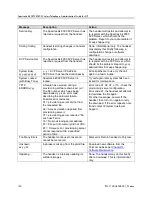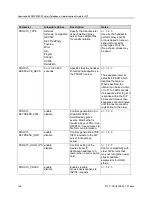
SpectraLink 8020/8030 Wireless Telephone: Administration Guide for SIP
140
PN: 1725-36038-001_N.docx
Version 2 Configuration Parameter Definition
The following table describes the parameters that can be used in the
Version 2 configuration files. The generic file is typically named
settings.txt. Note that double quotes can be used around the entire
value that a parameter is set to, with the exception of the
SIP_FAVORITES parameter. They can also be used to denote the
NULL string (“”). They cannot be used any other way except on the
SIP_FAVORITES parameter. See the sample file for more information.
Persistency
The handset saves configuration information in its memory and uses
it if the value is not available otherwise. This persistence is true for all
the parameters.
In order to remove a parameter that was previously set and no longer
needed, one must clear it or set it back to the default in the
configuration file. The null string (“”) can be used to clear out any
parameter that is a string or an IP address. Other parameters, such as
a port address, have to be deliberately set back to the default to get rid
of a particular definition. For parameters that are enabled or disabled,
just removing them from the configuration file does not disable them
if they were previously enabled, you must deliberately set them to 0
to disable them (for instance, the OAI_ENABLE parameter).
In some installations, it is advisable to set all user specific values, such
as lines, to the null string rather than leaving them unconfigured.
Precedence and how the handset initializes and uses the
supplied parameters
If the handset is configured to use DHCP, it initializes using the
values supplied by DHCP. Note that these values supplied by DHCP
are used by the handset, but they are not stored in persistent storage
on the handset. If any of the requested parameters are not supplied by
DHCP, values for those same parameters in persistent storage (if any)
will be used.
If the handset is not configured to use DHCP, it initializes using
values from persistent storage on the handset.
Next, the handset reads in the generic configuration file if possible.
Any values specified in this generic configuration file are saved in
persistent storage on the handset (overwriting any previously saved
data). The handset will start using the new values immediately as
long as these are values that do not require a configuration reboot.













































